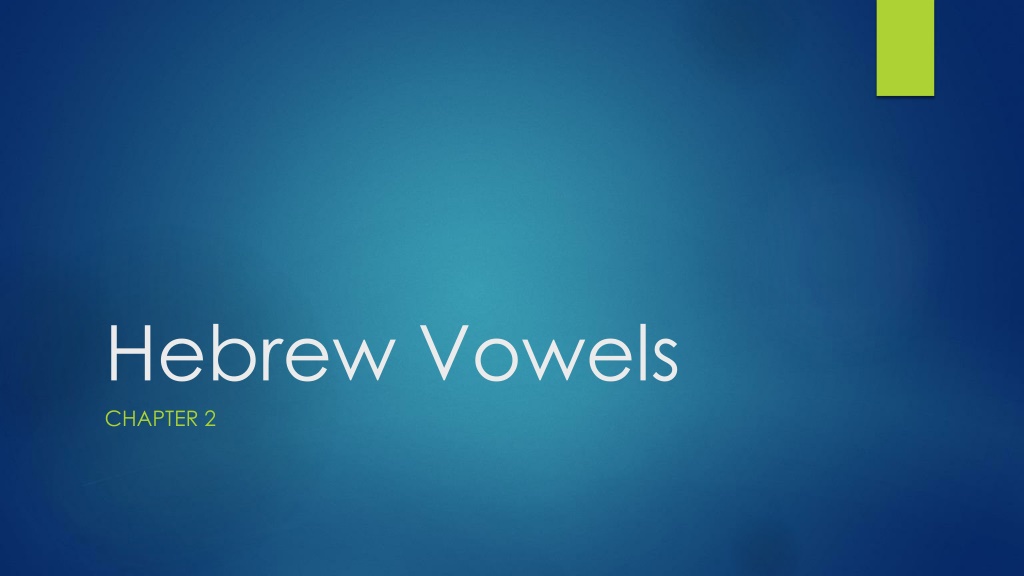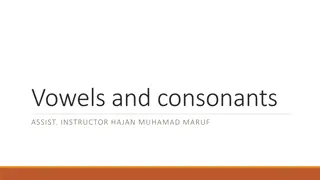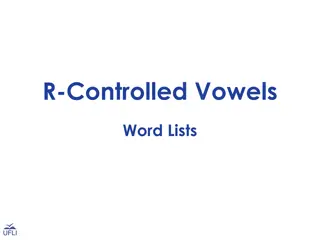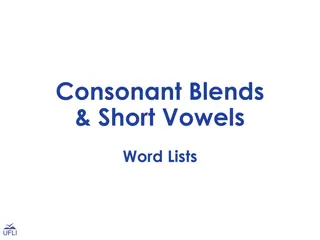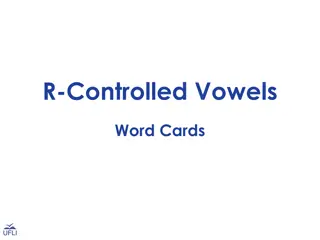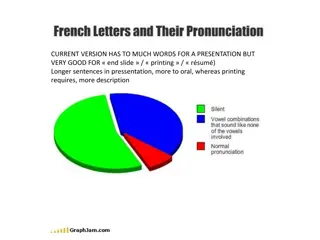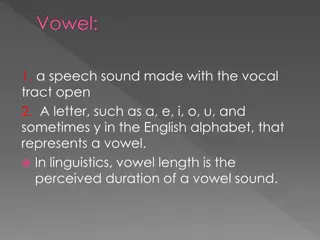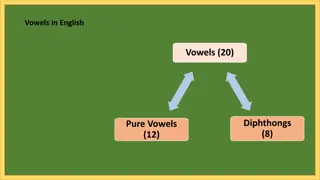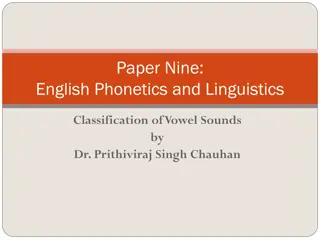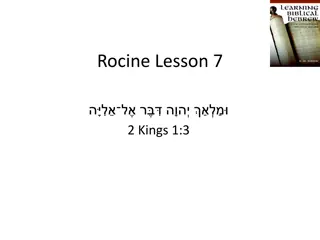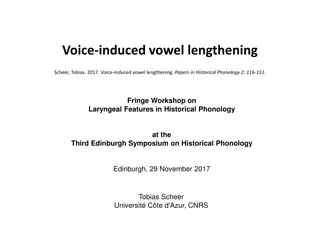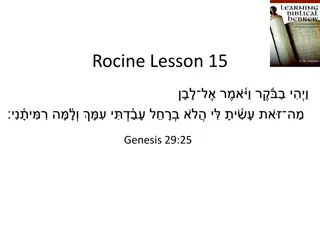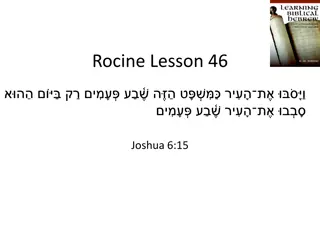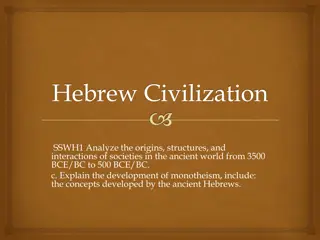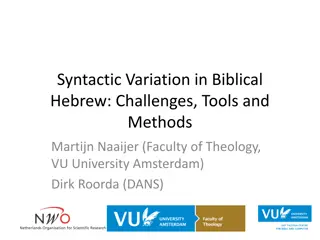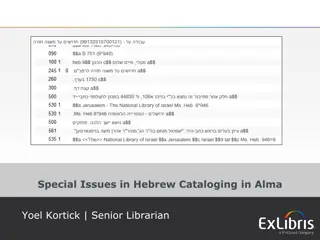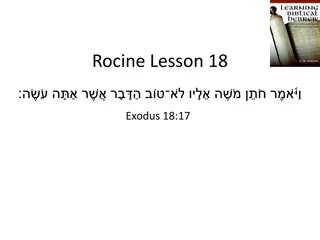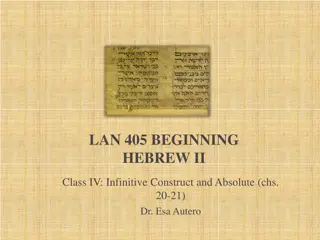Introduction to Biblical Hebrew Vowels: A Comprehensive Overview
Exploring the development and significance of Hebrew vowels in Biblical texts, this visual guide covers the evolution of vowel systems, the roles of the Masoretes in adding vocalization marks, and the distinctions between a-class, e-class, i-class, o-class, and u-class vowels. Delve into the nuances of Ketiv and Qere annotations, and grasp the intricacies of vowel pointing using vowel letters.
Download Presentation

Please find below an Image/Link to download the presentation.
The content on the website is provided AS IS for your information and personal use only. It may not be sold, licensed, or shared on other websites without obtaining consent from the author. Download presentation by click this link. If you encounter any issues during the download, it is possible that the publisher has removed the file from their server.
E N D
Presentation Transcript
Hebrew Vowels CHAPTER 2
Introduction to Biblical Hebrew Vowels (Niqqud) added by the Masoretes (500-1000 AD) Earlier: vowel letters added, matres lectionis (mothers of reading) and = a-class vowels for e-class and i-class vowels for o-class and u-class vowels Short, Long and half-vowels Ketiv( ) what is written; Qere( ) what is read
Vowels -- a-class Long (reducible) Q me in far Short Half Pata a in far a at f-pata in attach
Vowels -- e-class Long (reducible) er in they e in set in empire Short Half Segh l e at f-Segh l
Vowels -- i-class Long (reducible) Short Half req i in fit i
Vowels -- o-class Long (reducible) olem Q me atuf at f-Q me in so o in so Short Half o in commit
Vowels -- u-class Long (reducible) Short Half u Qibb u in rule ev
Vowel Pointing with vowel letters , , and Q me H in far in set / in they Segh l / er H / lem H in so
Vowel Pointing with vowel letters , , and / Segh l Y d / ere Y d in set ireq Y d in Marine in they
Vowel Pointing with vowel letters , , and req lem Vav in so in rule
Vowel List 1. Q me a as in far (Long) (Long) (short) a as in far 2. Q me h 3. Pata a as in far a 4. at f-pata a as in attach x (half vowel)
Vowel List (vowel let.) (short) 5. er e as in they e as in they (long) 6. er Y d 7. Segh l 8. Segh l Y d e as in set (vowel let.) e as in set x e as in set e 9. at f-Segh l (half vowel)
Vowel List 10. req i as in fit i (short) (vowel let.) (long) (vowel let.)) i as in ski 11. req Y d 12. lem o as in so o as in so 13. lem V v
Vowel List u (vowel let.) o (short) 14. Qibb u as in rule (short) u as in rule 15. req 16. Q me at f o as in so o as in commit x (half vowel) xe (half vowel) 17. at f Q me 18. ev e as in met
Hevenu Shalom Aleichem https://youtu.be/JB4RMIWroMY to you peace we bring
Open and Closed Syllables 1) Open syllable (begins with a consonant and finishes with a vowel, [CV =consonant vowel pattern] in ) 2) Closed syllable (begins and ends with a consonant [CVC=consonant vowel consonant pattern] in ). Tonic syllable is the syllable that is accented
Distinguish Qme (a-class) and Q me at f (o-class) Q me is an a-class long vowel ( l m) In contrast to Q me at f which is an o-class short vowel ( -- okm h). The general rule is if it is in a closed unaccented syllable it is a Q me at f (short o-class). Meteg ( ) which is a little vertical line to the left of the Q me E.g. [b ] where the meteg indicates a Q me is present not a Q me at f [bo]).
Dagesh Lene and Dagesh Forte A dagesh lene occurs in the begad kefat ( ) letters A dagesh forte is used in letters as a doubling dot for letters other than the begad kefat letters. If, however, the begad kefat letter is preceded by a vowel then the dagesh in the begad kefat letter is a dagesh forte or doubling dagesh dagesh in is a dagesh fore; transliterated dib|b r). follows a req vowel (in ) so the E.g.
Two Marks Mapp q (literally causing to go out ) So is transliterated with an ah (t mah) whereas without the mappiq it is as in ( okm ). Maqq f (literally binder )as in meaning from a king ).
Silent and Vocal ev Silent ev s (not pronounced or transliterated) and Vocal ev s (pronounced like the e in met, transliterated e ). Rule: If the consonant to the right has a short vowel the ev is silent (acts as a closed syllable [CVC] closer). If the vowel is long the ev is vocal. If, for example in (night), the initial pata is short so the syllable is divided to the left of the silent ev
Silent and Vocal ev If there are two ev s in a row inside a word the first is always silent and the second always vocal ( they guarded or kept). If there is a ev at the end of a word it is always silent While gutturals ( ) cannot take simple ev s, they do take composite ev s ( and seem to prefer pata as their vowel of choice. )
Defective Writing of Vowels The vowel letters ( ) are accompanied by a vowel as seen in the vowel chart ( ) but rather frequently the vowel letter is dropped. This is called defective writing. (full) (defective) (full) (defective) (full) (defective)
Gutturals and Furtive (stealthy Pata) A pata furtive is a hurried non-full pata vowel may be placed on the guttural or that end a word. While the pata furtive comes under the guttural it is transliterated before the consonant and superscripted like a at f-pata (transliterated r a , = wind, spirit)
Quiescent letters: and Both of these when they start a syllable are taken as consonants. However, when has no vowel it becomes quiescent (silent) and is not considered a consonant. When ends a word having no vowel after it, it becomes quiescent. note the consonantal and note the final quiescent note the quiescent
2.N. Speak and write Hebrew: good morning good evening good night good fortune Hello, good morning Hello Hello, good evening Hello Hello, good night Hello Good luck = congratulations!
Chapter 2 Vocabulary land, earth, ground 2,504 man, human 2,185 woman, wife 781 word, matter, thing 1,442 to go, walk 1,547
Chapter 2 Vocabulary Yahweh, Jehovah, LORD 6,828 day, daylight, time 2,300 Israel 2,506 no, not 5,185 king, ruler, prince 2,528
